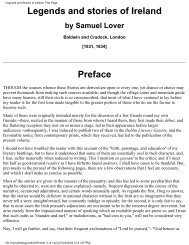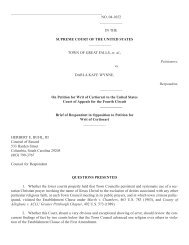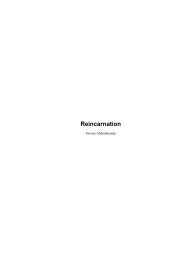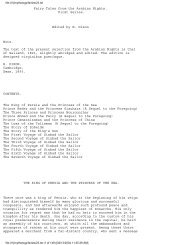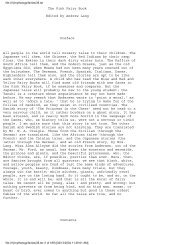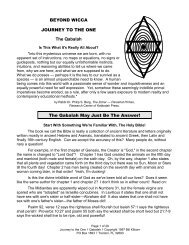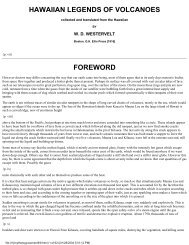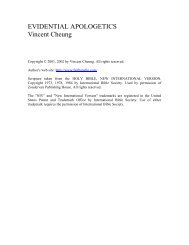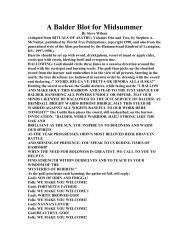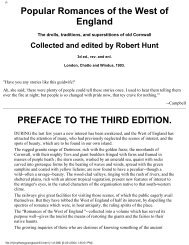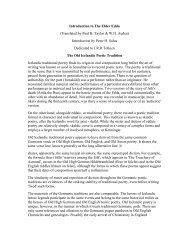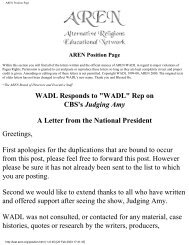Tales and Traditions of the Eskimo - Alternative Religions ...
Tales and Traditions of the Eskimo - Alternative Religions ...
Tales and Traditions of the Eskimo - Alternative Religions ...
Create successful ePaper yourself
Turn your PDF publications into a flip-book with our unique Google optimized e-Paper software.
<strong>Tales</strong> <strong>and</strong> <strong>Traditions</strong> <strong>of</strong> <strong>the</strong> <strong>Eskimo</strong> - Title Page<br />
tornarsuk, with <strong>the</strong> angakut as mediators. Their general aim may be said to be <strong>the</strong> counteracting <strong>and</strong><br />
defeating <strong>of</strong> witchcraft, at <strong>the</strong> same time serving to appease <strong>and</strong> influence <strong>the</strong> inue <strong>of</strong> nature, partly for<br />
<strong>the</strong> purpose <strong>of</strong> averting <strong>the</strong> danger p. 51 arising from <strong>the</strong>se powers, especially that <strong>of</strong> being frightened to<br />
death, partly in order to obtain what may be desired. Moreover, <strong>the</strong>y may be divided into two classes:<br />
first, <strong>the</strong> general religious means to be used by people in general for certain purposes or in certain cases;<br />
secondly, some peculiar faculties, which are possessed only by certain individuals.<br />
(1.) The General Religious Means.<br />
The general religious means may again be divided into three separate classes, <strong>the</strong> first consisting <strong>of</strong><br />
words to be spokenviz., prayer <strong>and</strong> invocation; <strong>the</strong> second, in <strong>the</strong> possession <strong>and</strong> application <strong>of</strong> certain<br />
material objects called amulets; <strong>and</strong> <strong>the</strong> third, <strong>of</strong> certain actions, such as <strong>the</strong> following out certain rules as<br />
to <strong>the</strong> mode <strong>of</strong> life, sacrifices, <strong>and</strong> different o<strong>the</strong>r observances for appeasing <strong>the</strong> ruling powers <strong>and</strong><br />
defeating witchcraft.<br />
In <strong>the</strong> prayer or serranek, as far as we know, only <strong>the</strong> desired object is pronounced, without any direct<br />
mention being made <strong>of</strong> <strong>the</strong> fulfiller; whereas <strong>the</strong> invocation (8ernaine8) is merely an appeal for aid to<br />
some special owner <strong>of</strong> power (8ernarpâ, he invokes him). It is not known whe<strong>the</strong>r in any <strong>of</strong> <strong>the</strong>se cases<br />
words <strong>of</strong> <strong>the</strong> pronouncer's own choice could be employed. The general custom, at all events, was to use<br />
distinct spells with peculiar tunes belonging to <strong>the</strong>m. Such a prayer was called serrat (in <strong>the</strong> tales<br />
translated by spell, magic lay, or song), <strong>and</strong> might have reference to health, hunting, assistance against<br />
enemies or dangersin short, whatever purpose might be desired within <strong>the</strong> limits <strong>of</strong> what was deemed<br />
right <strong>and</strong> proper. A serrat was supposed to have a power by itself, independent <strong>of</strong> <strong>the</strong> person who<br />
happened to know or make use <strong>of</strong> it. It was <strong>the</strong>refore considered an object <strong>of</strong> possession <strong>and</strong> barter; but it<br />
had also a deeper significance, in so far as a man in using it applied to a certain power, or had his<br />
thoughts fixed upon <strong>the</strong> fulfiller or <strong>the</strong> original giver <strong>of</strong> <strong>the</strong> spell, <strong>the</strong>se persons p. 52 being generally<br />
identicalviz., <strong>the</strong> nearest deceased kindred <strong>of</strong> <strong>the</strong> user. The serrats were in some cases expressly directed<br />
to <strong>the</strong> invoker's ancestors, <strong>and</strong> are also known to have been <strong>the</strong> hereditary property <strong>of</strong> <strong>the</strong> same family. In<br />
<strong>the</strong> same way, invocations were generally addressed to <strong>the</strong> souls <strong>of</strong> <strong>the</strong> gr<strong>and</strong>parents, <strong>and</strong> were<br />
principally employed as a preventive against being frightened to death. A serrat had to be originally<br />
acquired by a revelation to some individual who possessed a certain degree <strong>of</strong> angakok-wisdom, <strong>and</strong> in<br />
most cases <strong>the</strong>y probably dated from very remote ages. The serranek was chiefly practised by old men,<br />
who, while performing it, partly uncovered <strong>the</strong> head.<br />
The amulets, or arnuat (plural <strong>of</strong> arnua8), were small articles which ei<strong>the</strong>r permanently belonged to <strong>the</strong><br />
individual, <strong>and</strong> in this case were always carried about his person or worn on <strong>the</strong> body or inserted in his<br />
weapons, or were sometimes only acquired for certain special occurrences. The efficacy <strong>of</strong> an amulet<br />
depends firstly on <strong>the</strong> nature <strong>of</strong> <strong>the</strong> original thing or matter from whence it has been derived. To serve<br />
this purpose, certain animals or things which had belonged to or been in contact with certain persons or<br />
supernatural beings were chiefly chosen; <strong>and</strong> sometimes, but more rarely, also objects which merely by<br />
<strong>the</strong>ir appearance recalled <strong>the</strong> effect expected from <strong>the</strong> amulet, such as figures <strong>of</strong> various objects.<br />
Undoubtedly <strong>the</strong> original inua <strong>of</strong> <strong>the</strong> objects was believed to be still acting by means <strong>of</strong> <strong>the</strong>m. Those in<br />
most esteem were objects pretended to have belonged to <strong>the</strong> ingnersuit <strong>and</strong> <strong>the</strong> inuarutligkat. Very<br />
precious amulets were got from <strong>the</strong> avingak, which in Labrador signifies a kind <strong>of</strong> weasel, but in<br />
Greenl<strong>and</strong> a fabulous animal, <strong>and</strong> <strong>the</strong> application <strong>of</strong> which in a tale from both countries exhibits a most<br />
striking similarity. It is also said to serve <strong>the</strong> western <strong>Eskimo</strong> for amulets. Probably <strong>the</strong> choice <strong>and</strong><br />
appreciation <strong>of</strong> things most useful <strong>and</strong> appropriate for amulets was p. 53 akin to <strong>the</strong>ir faith in different<br />
file:///I|/mythology/american indian/24/24.html (36 <strong>of</strong> 317) [01/24/2004 8:57:49 AM]



